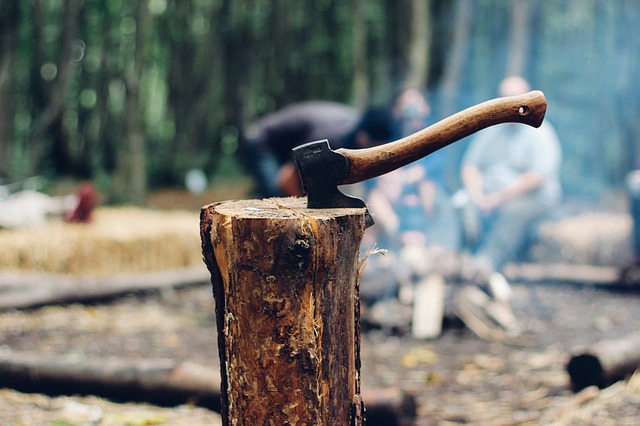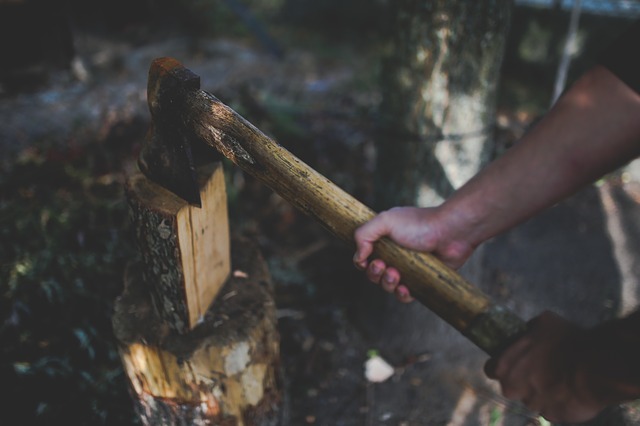Axe welding and striking is a great skill to have, however it’s not as simple as grabbing one and cutting everything you want with no attention to your surroundings and without knowing the difference between a hatchet and an axe.
When you know the fundamentals, you will soon realize that there’s a lot more complexity to it.
This will help you understand the axe a lot better and when you do, this will allow you to push your bushcraft axe skills to the next level!
If this sounds like something you want to learn then I suggest you keep reading…

Safety First – Hatchet VS Large Axe
The Hatchet Is More Dangerous, Wait…WHAAAAAT?
Yes, you read that correctly. The small hatchet might look like a cute little toy to most people, however it’s actually a lot dangerous than its older brother.
By using the hatchet without practice, can land you in a hospital bed and in a hell of a lot of pain. Remember that the hatchets follow-through body parts are your thigh and knees, and the amount of space between you and the sharp head is not that far.
Pros Of A Hatchet
- A hatchet is lighter
- Easier to carry
- More compact
Cons Of A Hatchet
- More dangerous, not recommended if you have no experience
- Takes longer to cut wood
- Requires more energy to finish the job
How To Strike With The Hatchet
The safest way to use a hatchet (because of the deadly consequences) is from a kneeling position. I don’t care how Rambo you think you are, no body wants to see a hatchet sticking out of somebody’s leg!
And for your own sake, please don’t hold a piece of wood while you attempt to cut it, if it’s too thin to stand on its own, then the safest way is with a full tang construction knife.
When splitting wood with your hatchet – I highly suggest you use a block, then place your piece of wood you want to chop on the other end of the block, therefore any miss-placed strikes is going to hit the block and not your leg.
Large Axe – The Hatchets Counterpart
A longer axe is actually safer than a small hatchet because of the long range between your body parts and the deadly head.

Your Grip
Gripping an axe should be firm but not hard, otherwise you’re just restricting blood flow and making your hands feel colder in freezing temperatures.
Hold the axe firm enough to cut wood sturdily and efficiently, and without gripping it too loosely, which will just cause the axe to fly out of your hand or fling back and hit somebody.
How To Strike (RAAARRR)
How to strike using the axe:
- The hand closer to your body will stay stationary
- While the hand closest to the head will remain in the middle of the handle.
- Lift the axe above your head
- Now slide your hand down (the one closest to the head) to meet your other hand as you strike the axe into the wood, maximizing power and giving you full control of the axe.
Your First Training Step
Practice cutting wood with a LARGE AXE. If you miss the wood you’ll dig straight into the dirt, and NOT your toes, lower leg or knees.
Your Second Training Step
When you have cut hundreds of blocks of wood and learned how to complete it efficiently and safely, then I can suggest you move on to practicing with a hatchet.
Note: Be extra careful with a hatchet! (especially for the first few tries) The hatchet is much lighter and without watching your force, you may strike too hard, underestimating the placement of the wood causing you to completely miss and do some damage to yourself.
Let’s Get Into The Good Stuff – Axe SKILLS
Firewood
Yes, collecting and chopping firewood might be a basic activity, but it’s where it got you to where you are today. This will be your first learning phase, then when you have mastered this – move on to the next.
Faster Firewood
We all know how much of a pain and daunting task is when chopping regular firewood. However, cutting off branch limbs is a lot quicker and energy-efficient than cutting a big ol’ tree.
Look for dry, dead branches hanging off a tree, then smash that bad boy off in a single blow using the sharp head of your hatchet.
Hammering
That hammer on the hatchet really is a hammer! (taking into consideration that you bought this type of hatchet) I shouldn’t need to tell you how to use a hammer because we are taught from our first year of primary/elementary school how to use one. This one is just a lot dangerous, so be careful when hammering things – I don’t want you to come and blame me when you lose an eye.
Processing Animals
If you’re an avid hunter and processor you know that breaking animals legs and chopping off their limbs is not as easy as it looks. With the help of a hatchet, this makes the entire task that much easier, so be sure to sharpen up that head and keep it sharp.
Tree Felling
Think and plan before you chop a tree down. You may already have simple wood all ready to go, just waiting to be burned – from easy-to-get dead limbs.
This guide teaches you how to fell a tree in a safe and efficient manner.
Build Better Structures
Living or even staying in the outdoors is a wonderful thing to do, knowing how to build bigger structures will give you a huge confidence boost and help you connect more with Mother Nature AND with yourself.
- Create a cooking tripod out of sticks
- A more homey shelter
- Actually build a proper fence around your campsite!
- Or build a fence around your garden
- A table and chair will come in handy
- If you want something more advanced, build a deck 😀
- You also need a workbench for all those projects
The possibilities are endless, and only you can make the difference in your outdoor experience. Learn more, craft more and most of all have fun.
My Final Thoughts
Axes have been with humans since the start of our existence and have been using them with great success since, it is only smart to keep using them and learning more about them.
It’s not all about chopping and slashing, or even hammering if you have that type of hatchet, it is also about caring for your axe and keeping it sharp and in return – it will care of you.
If you found this post helpful, please leave a comment below.
Or if you want to increase your bushcraft knowledge even further, here’s a list of skills you can do with a bushcraft knife.



I always thought that hatchet is safer and I guess I could not be any more wrong.
I have no experience with hatchets. Some friends and I will be going to a lake house I guess none of them have any experience with hatchets either. I think we should just go with Large Axe.
You would think the hatchet is safer, but that is certainly not the case. It’s entirely up to you for which one you want to take. But do keep in mind that the hatchet is lighter and easily maneuverable, and that’s why you’re more prone to getting cut or injured, due to its ultimate simplicity.
Cheers,
Brandon